After a couple of days spent in Heraklion, I used an inter-city coach in order to move to Chania, a town in the northwest of Crete. Along the way I enjoyed the beautiful sights of the largest Greek island.
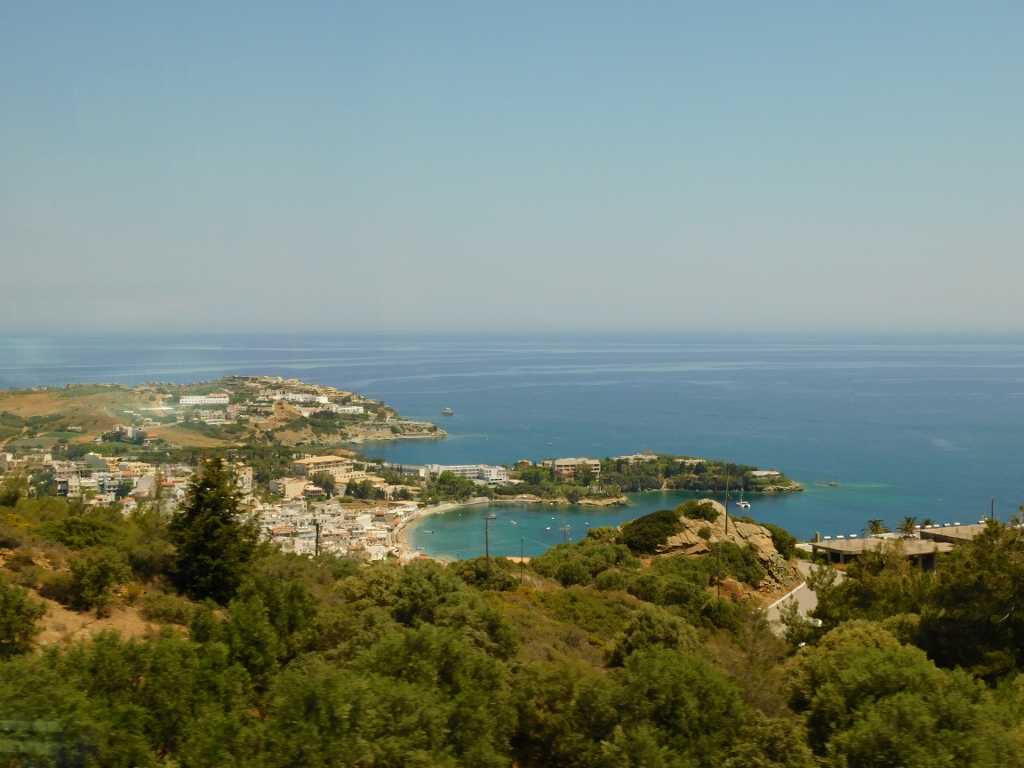 On the way from Heraklion to Chania
On the way from Heraklion to Chania
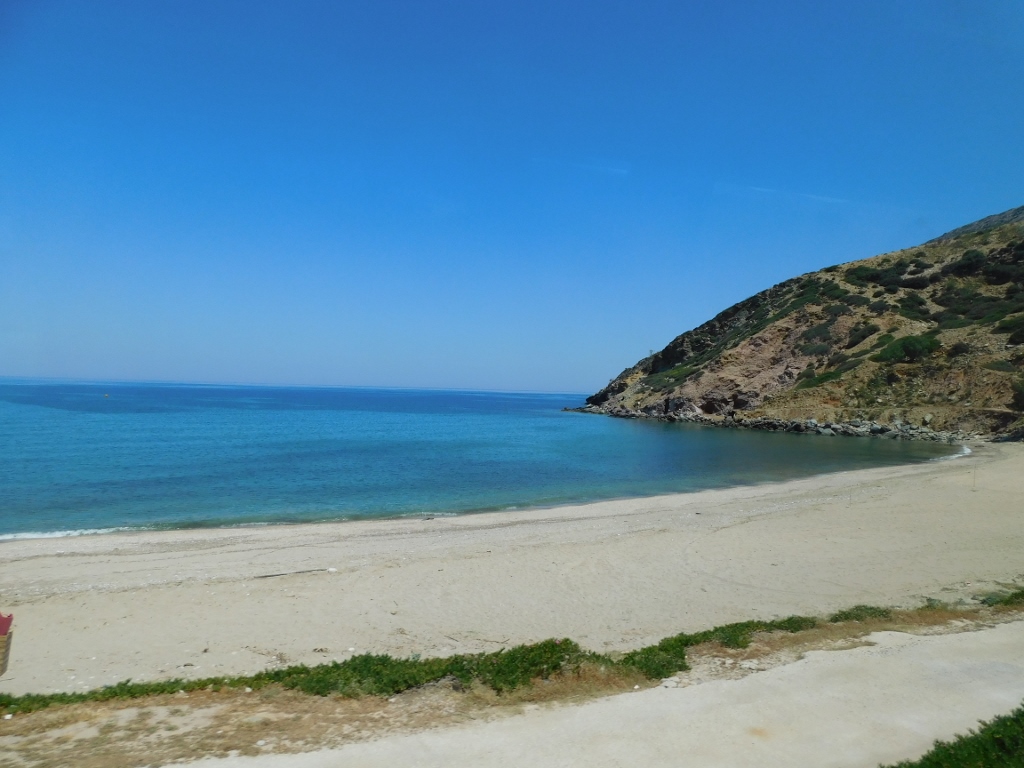 On the way from Heraklion to Chania
On the way from Heraklion to Chania
By the way, here is the map that shows what I visited during my stay in Crete in May 2022.
Crete is one of the best known places in the world for growing olives and this is also where vine and citruses are cultivated. I could see some of that from the coach.
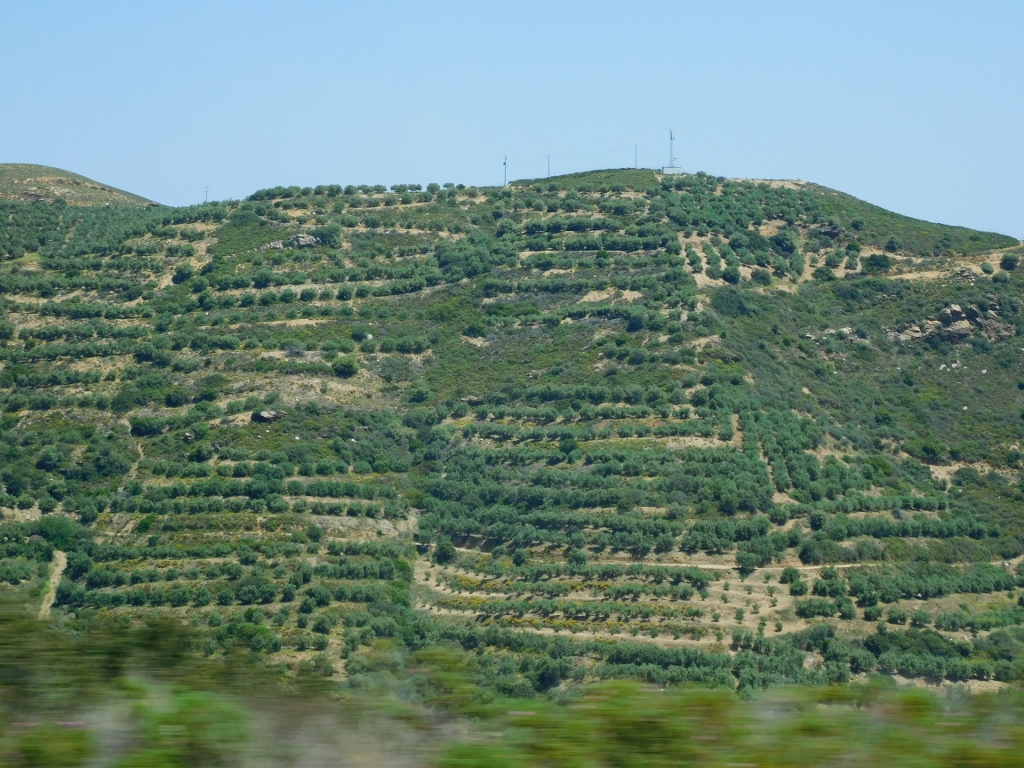 On the way from Heraklion to Chania
On the way from Heraklion to Chania
Also, although it was the middle of May and although Crete is only 200 km north of Africa, I could still see some snow on the highest mountain on the island. This is in fact a mountain massif Psiloritis, while the highest mountain within the massif is Ida with the summit at 2456 m.
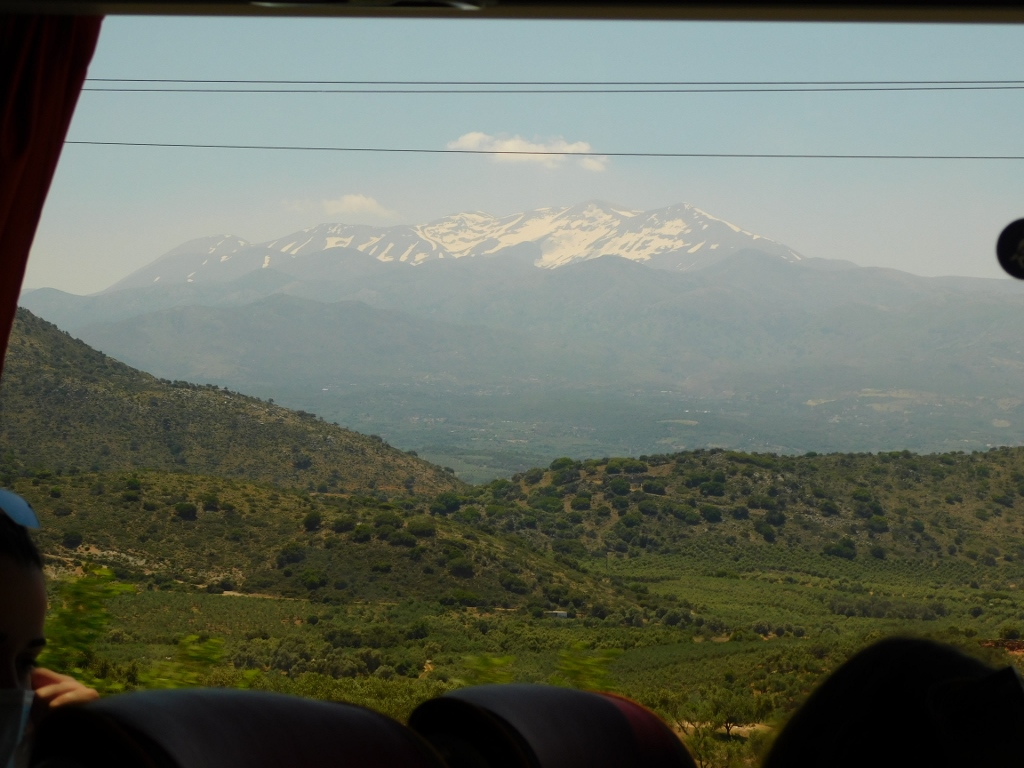 On the way from Heraklion to Chania
On the way from Heraklion to Chania
Having arrived in Chania, I first went to the flat I had rented in the old part of the town, not far from the Old Venetian Port of Chania, in order to leave my things there. The flat had a tiny ground plan, but it had two upper floors, so on the top I had an equally tiny balcony with a nice and picturesque view. I was content with my choice.
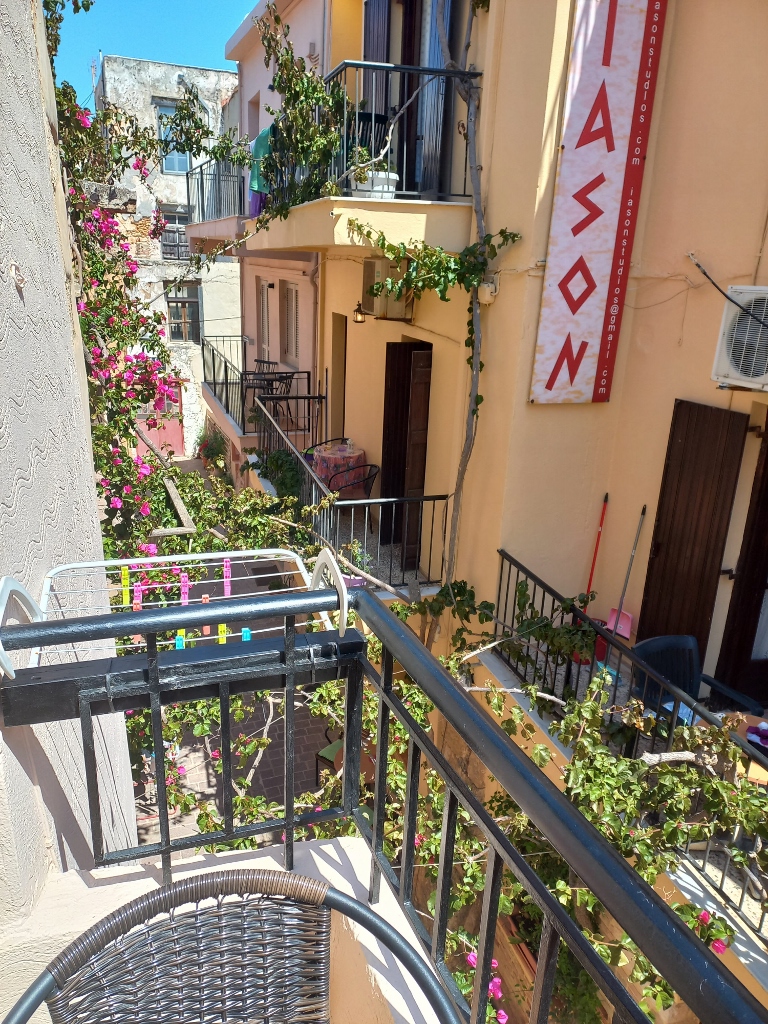 Balcony with a view
Balcony with a view
Soon I left my things and went for a walk to the port that looked magical. It takes up the space of a deep bay, something between a horseshoe and a funnel shape, with a promenade around and an uninterrupted line of restaurants and cafés. Opposite the back of the bay, there is the Lighthouse of Chania and beside it a passage leading out to the open sea.
 Old Venetian Port of Chania
Old Venetian Port of Chania
 Old Venetian Port of Chania
Old Venetian Port of Chania
On the east side of the bay with the old port, one can see the Küçük Hasan Pasha Mosque built by the Ottomans in 1645 following the conquest of Chania. After the Population Exchange between Greece and Turkey in 1923, the mosque stopped functioning as such and its minarets were destroyed in 1939. Today, it is used as an exhibition hall.
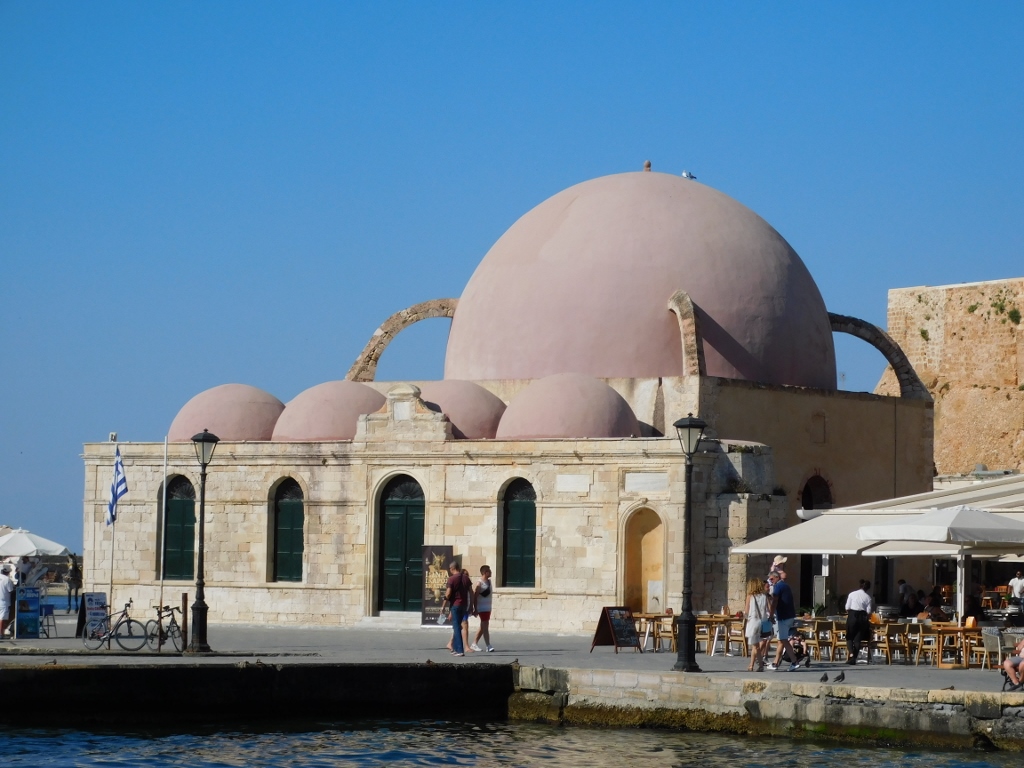 Küçük Hasan Pasha Mosque
Küçük Hasan Pasha Mosque
Then I meandered back again into the small picturesque streets of Chania enjoying the sights I was surrounded with.
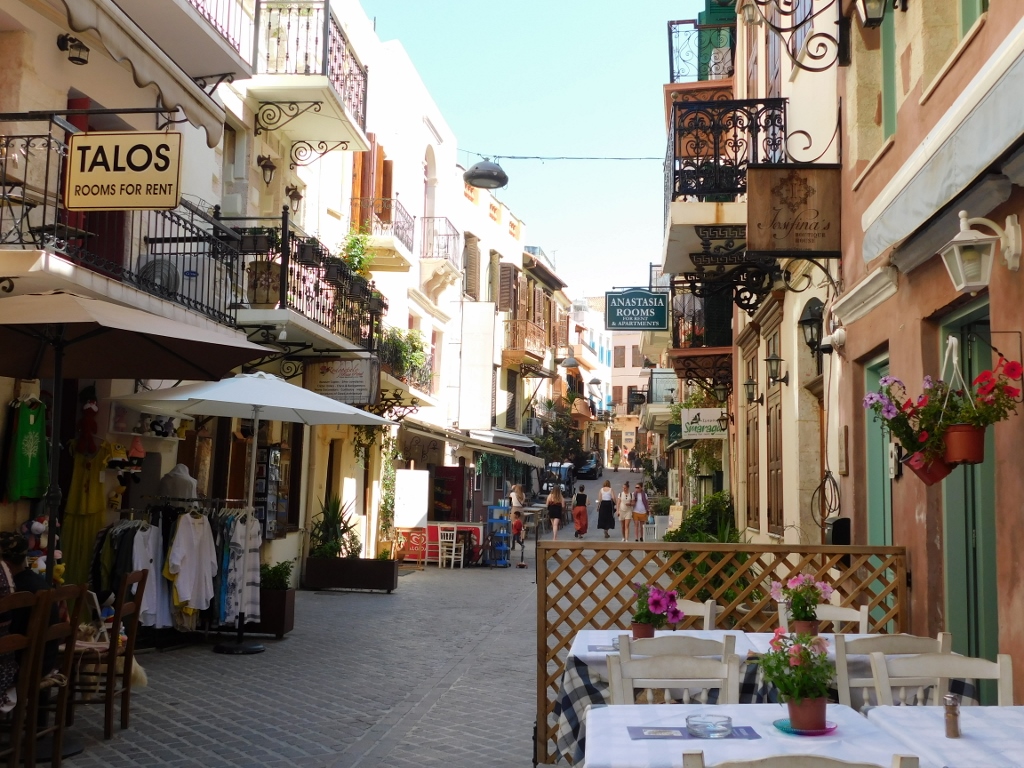 Chania, a detail
Chania, a detail
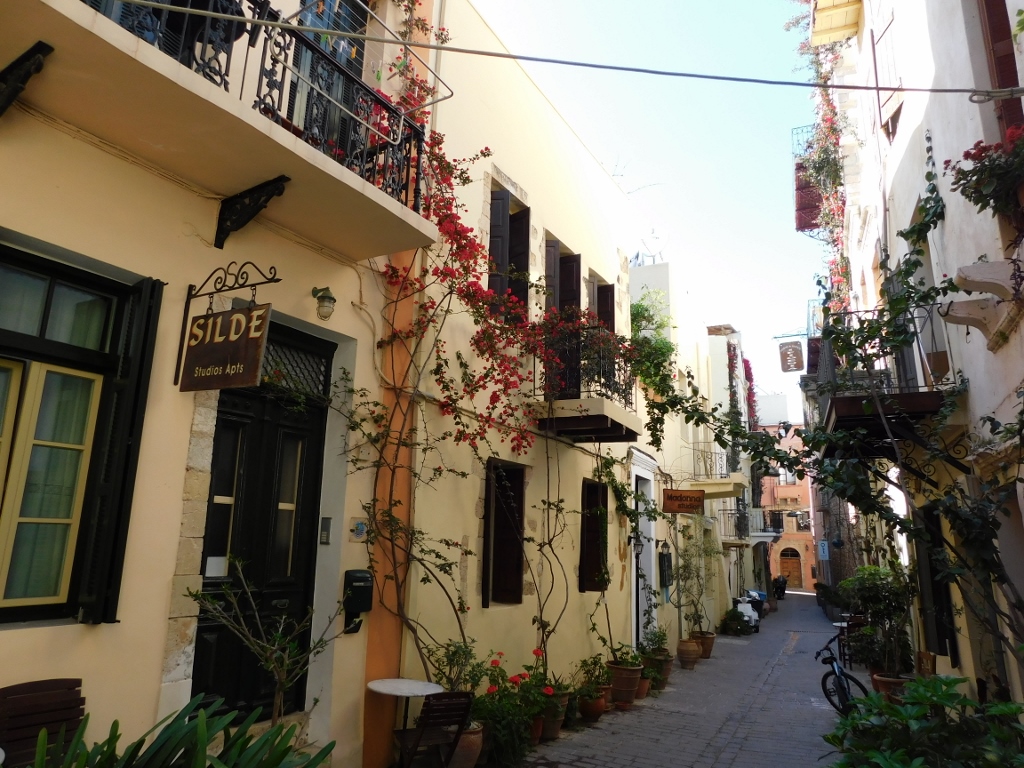 Chania, a detail
Chania, a detail
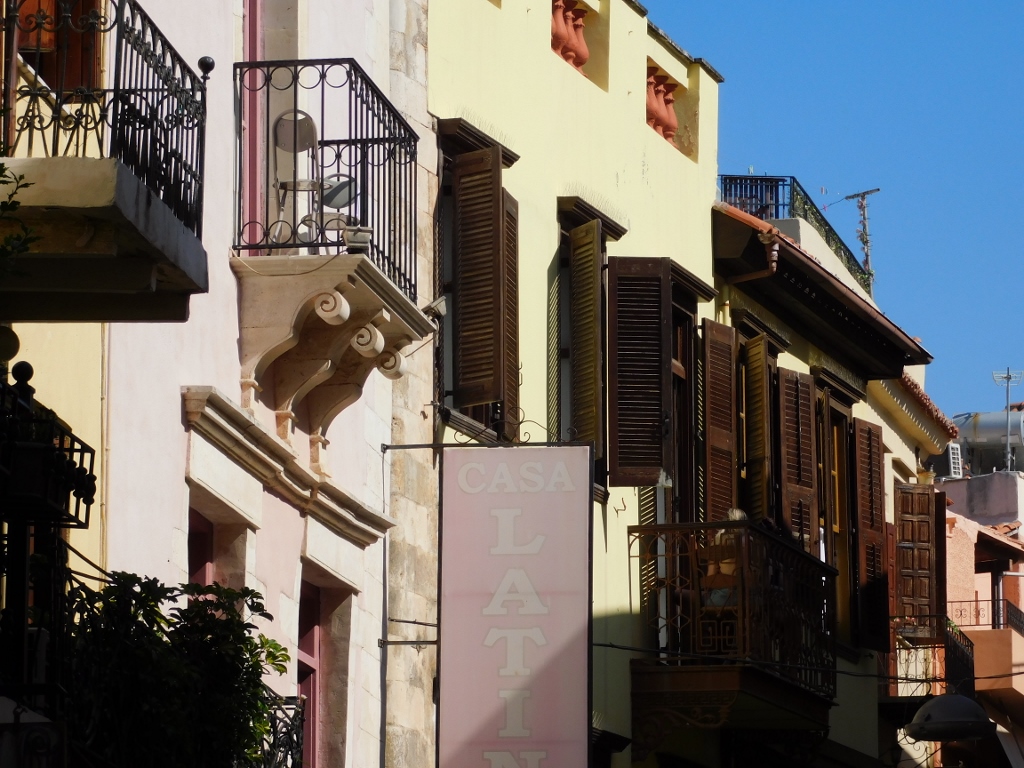 Chania, a detail
Chania, a detail
In general terms Chania certainly followed the history of the rest of Crete and so the Venetians came here in the 13th century. The town was named La Canea and the Venetians strengthened the fortifications the parts of which can be seen even today. Regardless of the Greek and the Byzantine influences in the subsequent period, the Venetians reigned supreme here until the middle of the 17th century and that influence is still noticeable.
From 1645, it was the Ottomans who came here and of course their influence is very visible as well. They remained here as undisputed rulers until the Treaty of Berlin in 1878 when Crete was given broad autonomy. The fight for independence continued nonetheless. Without getting into too many details now, there were uprisings and direct meddling and presence of the Great Powers, as well as disputes between Greek monarchists and republicans. All in all, Crete joined Greece on 1 December 1913 after the Balkan Wars.
It is interesting that Chania was declared the capital of Crete in 1898 and it had this function until 1971.
After the first encounters with the port and some small streets of the old part of Chania, I started with some more serious sightseeing and so I went to the main walking street in the old town called Chalidon.
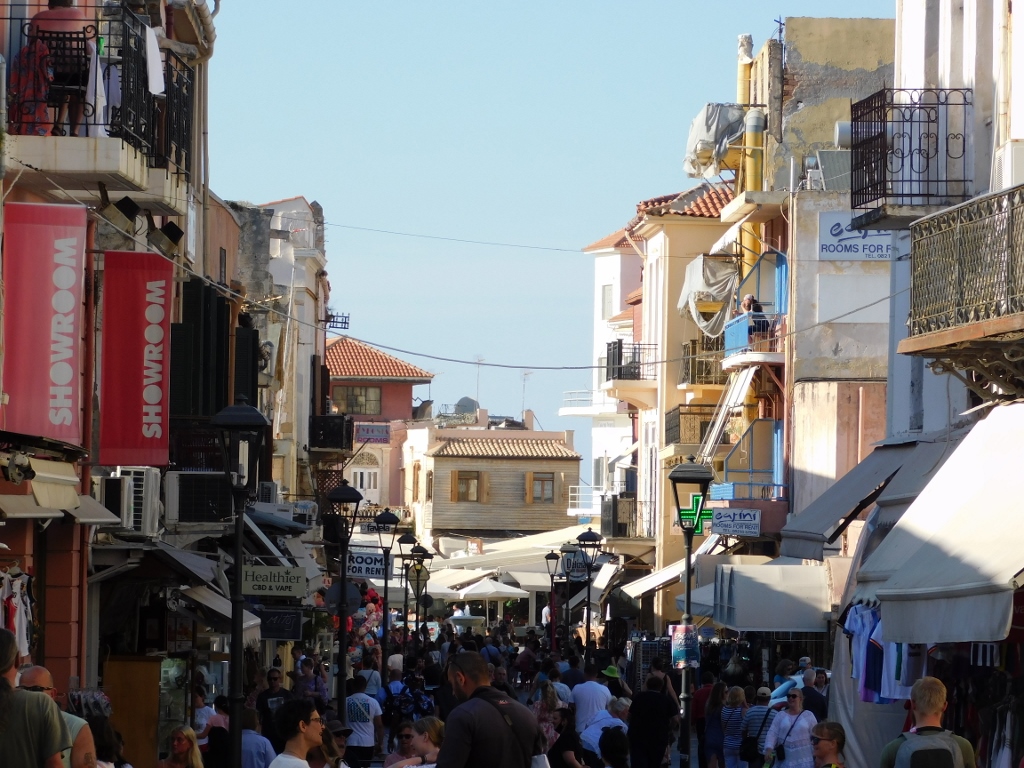 Main pedestrian street in Chania
Main pedestrian street in Chania
There I passed by the former Archaeological Museum of Chania that until 2020 used to be at the former Venetian Monastery of St. Francis. Nowadays, the museum is placed in a modern building in another part of the town, while this former monastery seemed completely closed at the time of my visit.
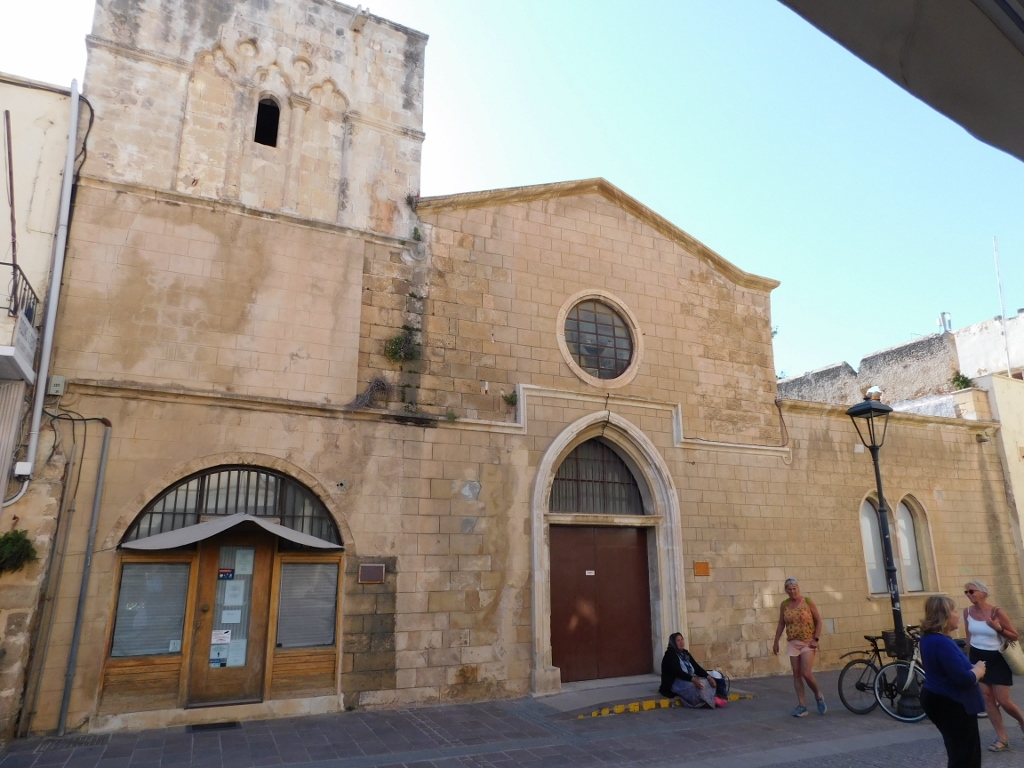 Former monastery and former museum
Former monastery and former museum
Across the street there is a building in which there are some shops today, but judging by the appearance it seemed to me like a former hamman or the public baths from the Ottoman period.
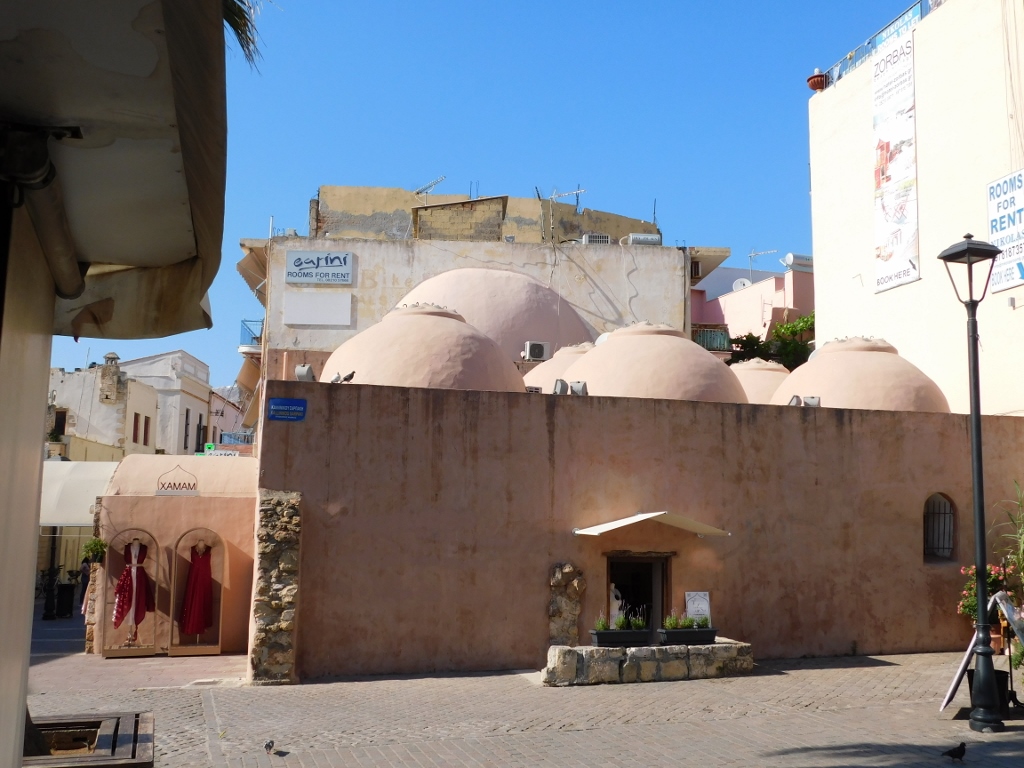 Former hammam
Former hammam
There is also a small square with the Cathedral of the Presentation of the Virgin Mary.
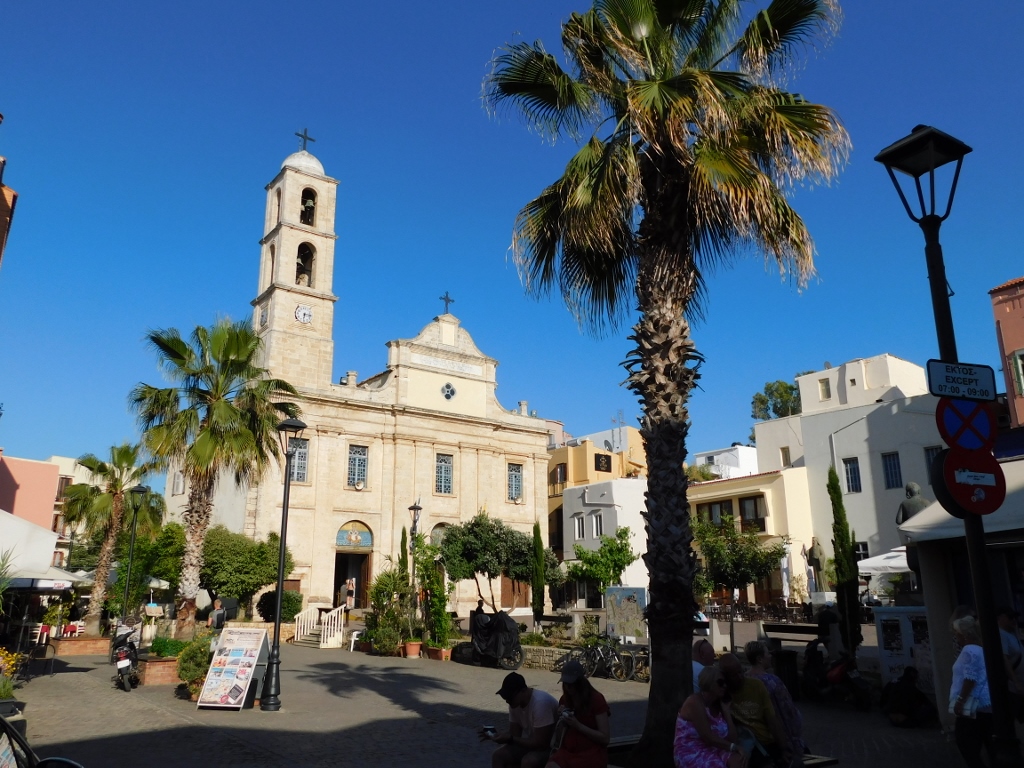 Chania Cathedral of the Presentation of the Virgin Mary
Chania Cathedral of the Presentation of the Virgin Mary
The church was built during the Ottoman rule, between 1850 and 1860, at the site of an older and smaller church from the 11th century. But, let there be no mistake – it was not the Ottomans who demolished that old church, but the Venetians who built some kind of a warehouse here which the Ottomans later turned into a soap factory. Around the middle of the 19th century they gave this area to the Christian community and so the church that can be seen here today was built at this site. It is interesting that it has three naves with the middle one dedicated to the Presentation of the Virgin Mary, the south one to the Three Hierarchs and the north one to St. Nicholas.
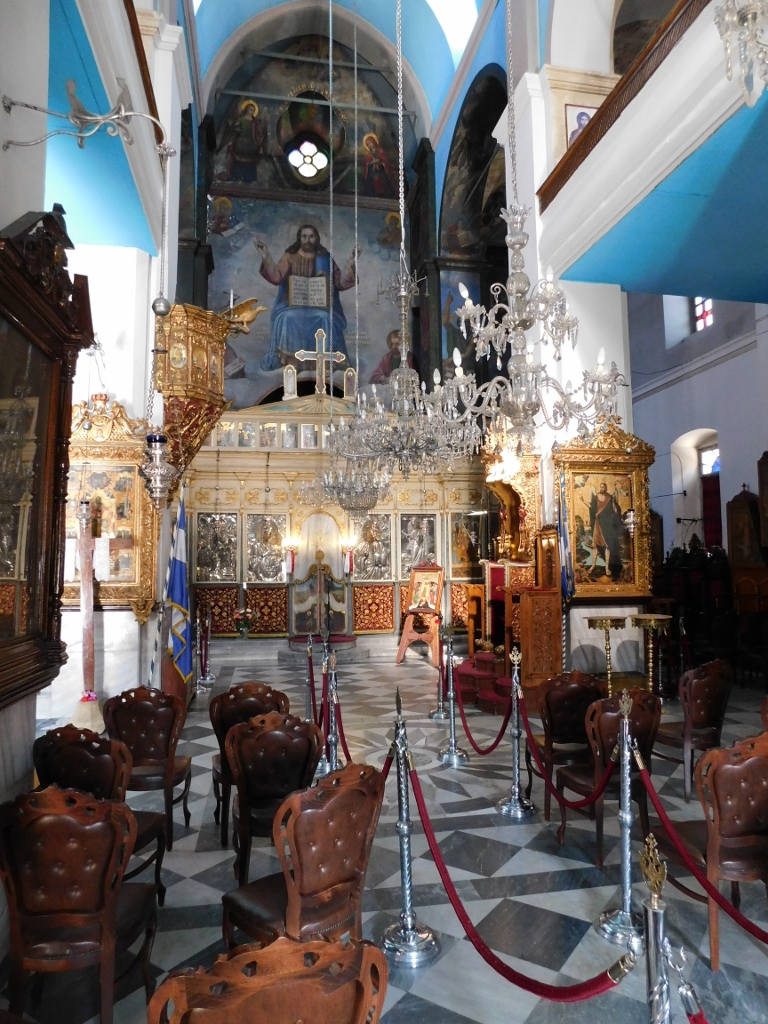 Cathedral of the Presentation of the Virgin Mary, the interior
Cathedral of the Presentation of the Virgin Mary, the interior
Then I went again into the small streets west of the main walking street, since I wanted to have lunch which happened soon enough.
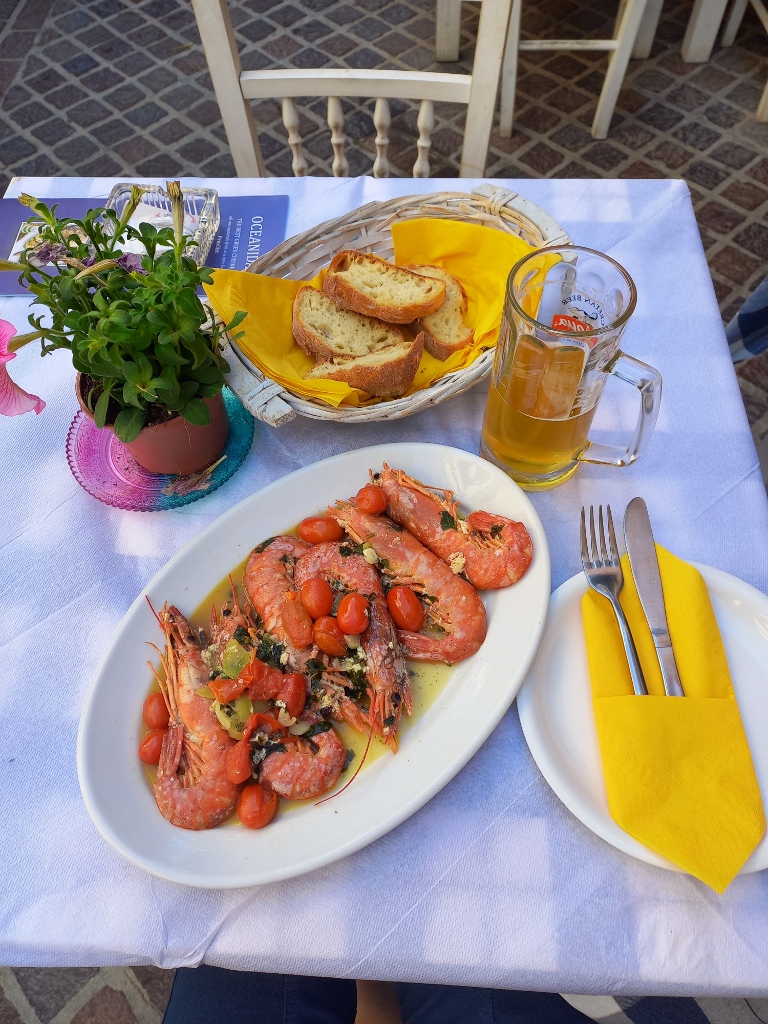 Lunch in Chania
Lunch in Chania
After the delicious lunch and some afternoon rest, I went out again and continued with my sightseeing. There were interesting and picturesque details all over the place.
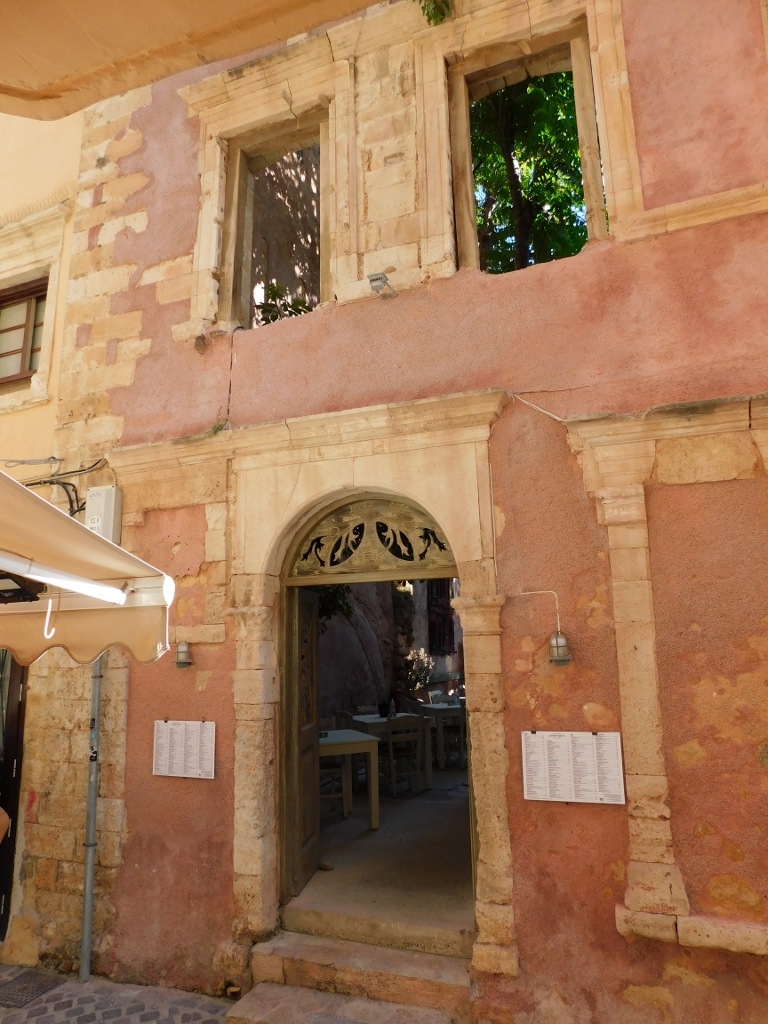 Only the facade has remained, while the interior of the former house now hosts a garden and a restaurant
Only the facade has remained, while the interior of the former house now hosts a garden and a restaurant
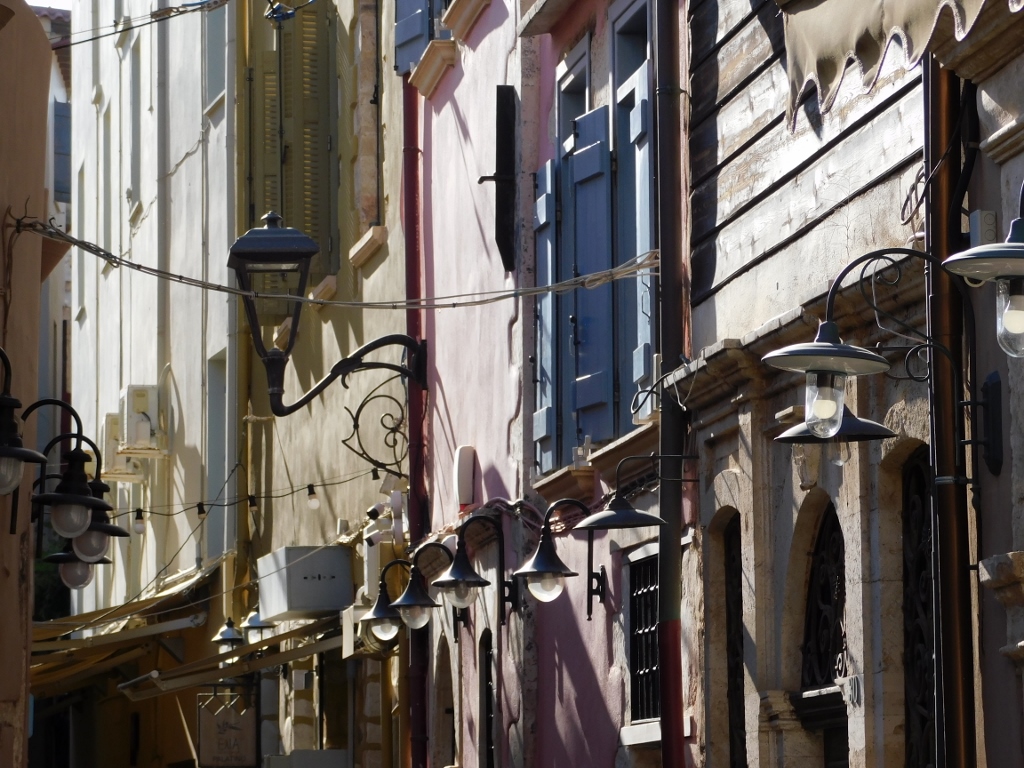 Chania, a detail
Chania, a detail
This time I headed for the east part of the old town, since I wanted to see the remains of yet another Minoan palace here. This is the palace in Kydonia.
Namely, the first organised Minoan settlement on the territory of the present-day Chania was founded near the natural harbour in the period 3500-2000 BCE, on a low hill nowadays called Kastelli and this is the east part of old Chania. The Chania of today lies precisely over the remains of this town which as a Neopalatial (approx. 1700-1450 BCE) and Mycenaean (1450-1200 BCE) settlement became over time the most important settlement in western Crete. It was a quite well organised, urbanised town, but today the visitor can only see some rugged remains in several locations.
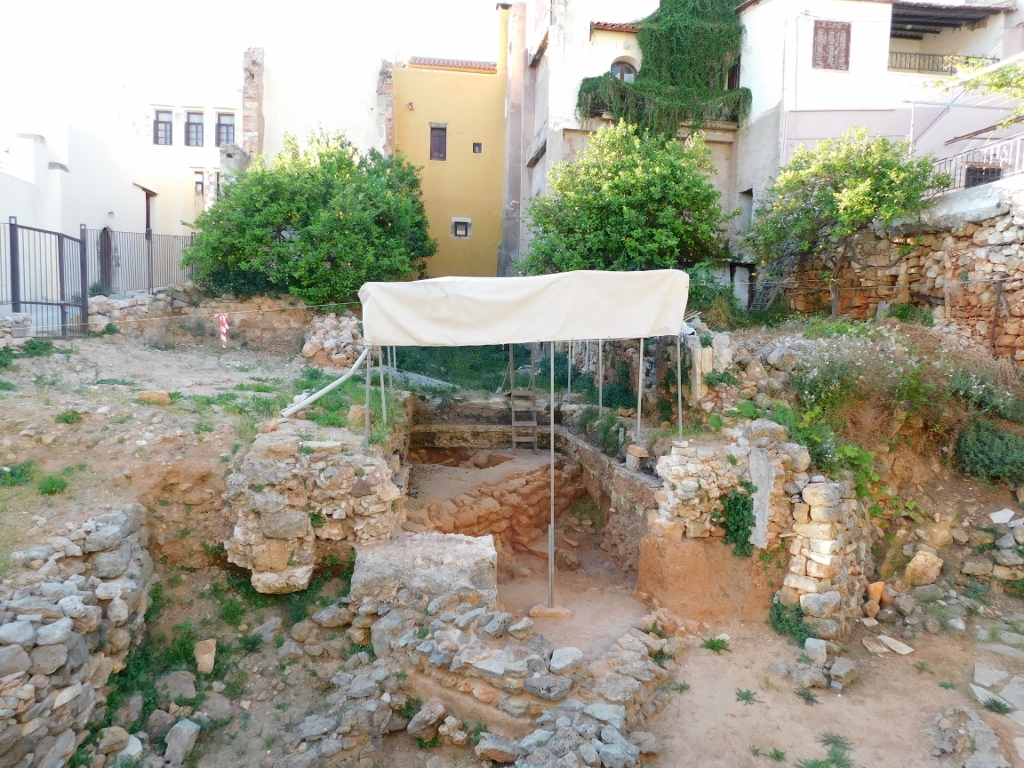 Remains of old Kydonia
Remains of old Kydonia
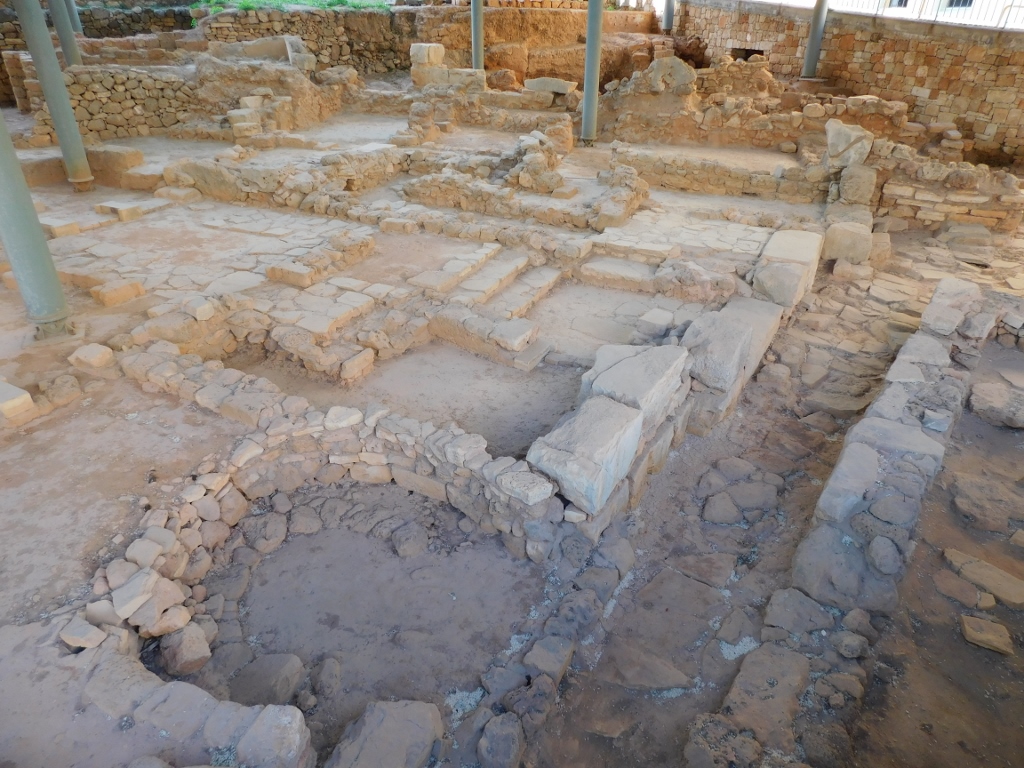 Remains of old Kydonia
Remains of old Kydonia
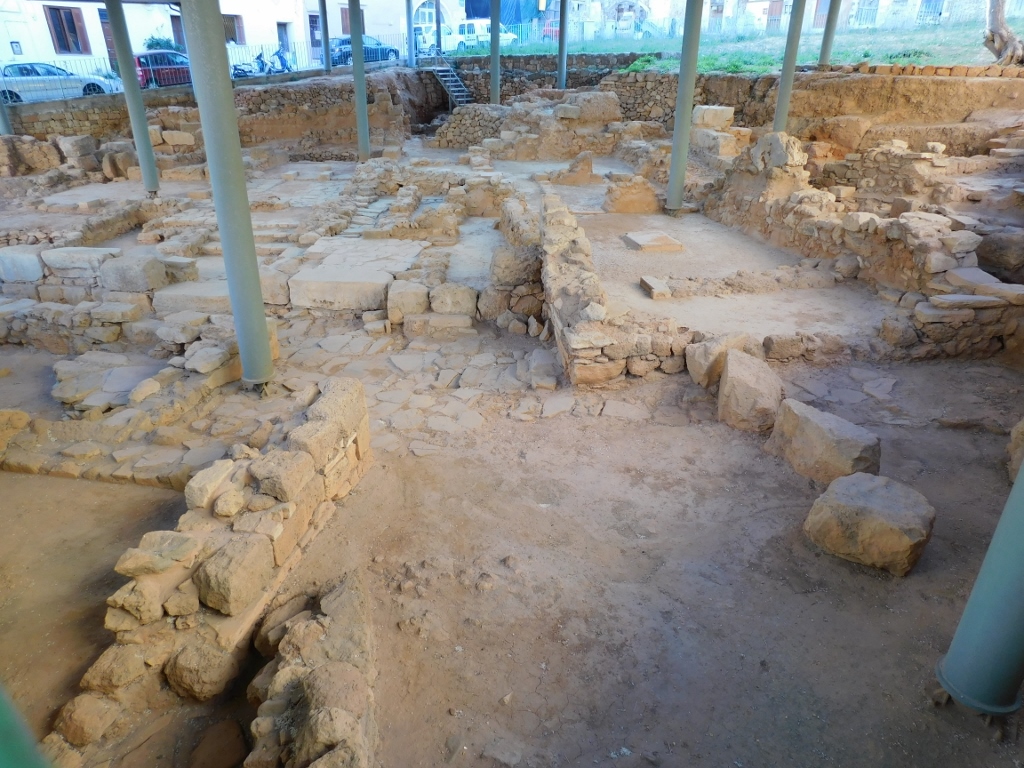 Remains of old Kydonia
Remains of old Kydonia
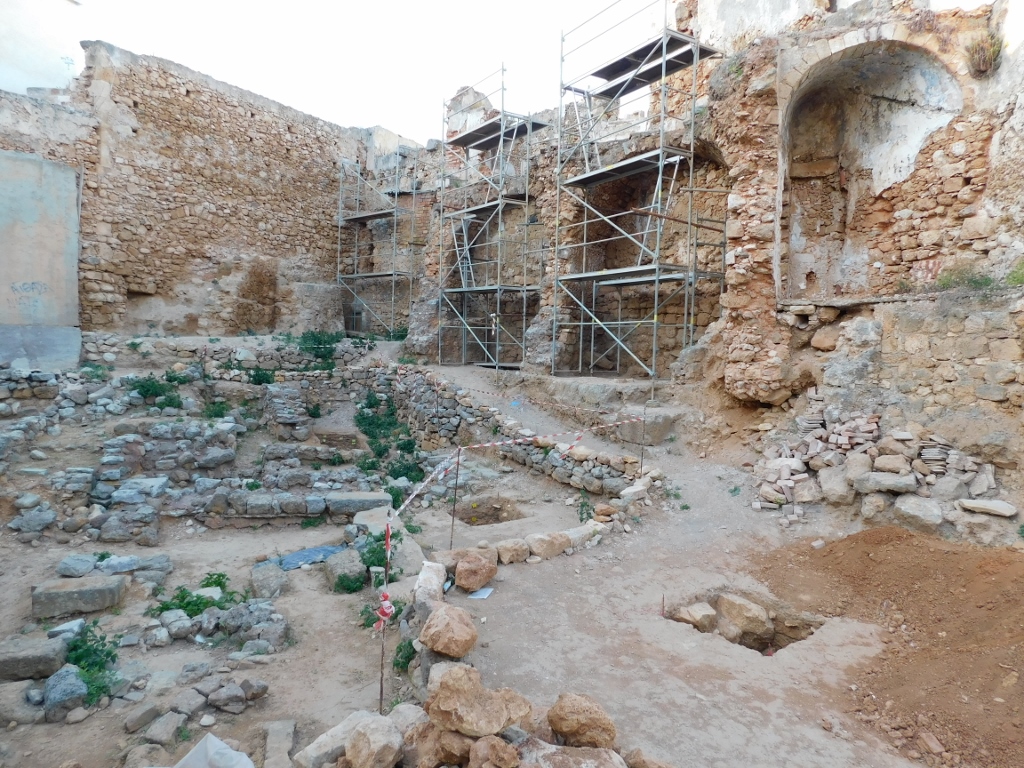 Remains of old Kydonia and the walls built by the Venetians
Remains of old Kydonia and the walls built by the Venetians
Continuing with my sightseeing of Chania, I reached the Venetian Church of St. Rocco from 1630 which, according to what I could find, is used nowadays as an exhibition hall.
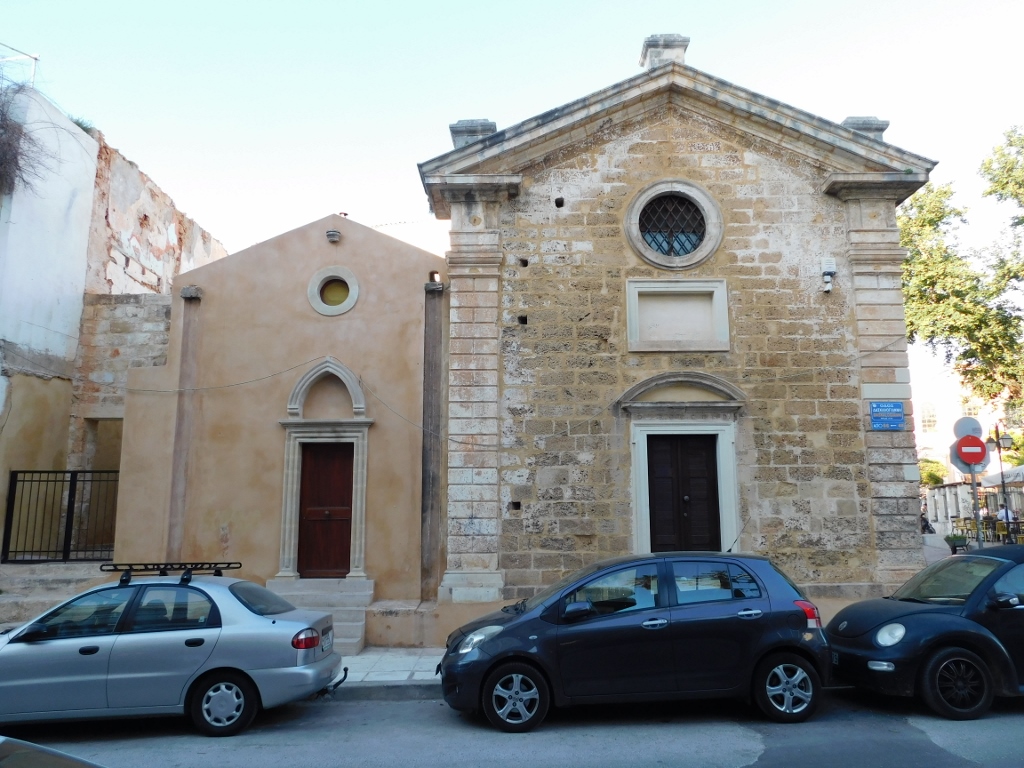 Church of St. Rocco
Church of St. Rocco
The side section of this church faces the 1821 Square with an exceptionally interesting Church of St. Nicholas.
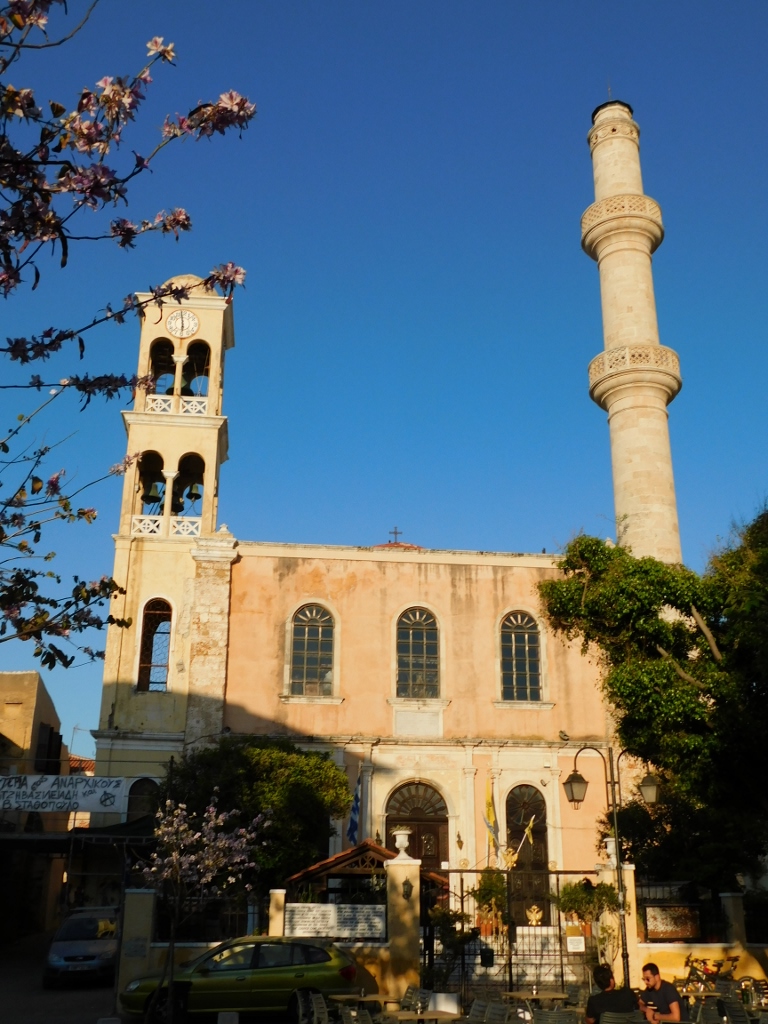 Church of St. Nicholas
Church of St. Nicholas
The construction of this church for the needs of the Dominican order started in 1205 and lasted until 1320. In other words, it took place during the Venetian rule over Crete. Needless to say, after the Ottomans had taken over Chania, in 1645, the church was turned into a mosque and a minaret was added. In 1918, the edifice became an orthodox church. In other words, the owners and users kept changing, but the bell tower and the 36 m tall minaret have survived and this is what renders a special charm to this church.
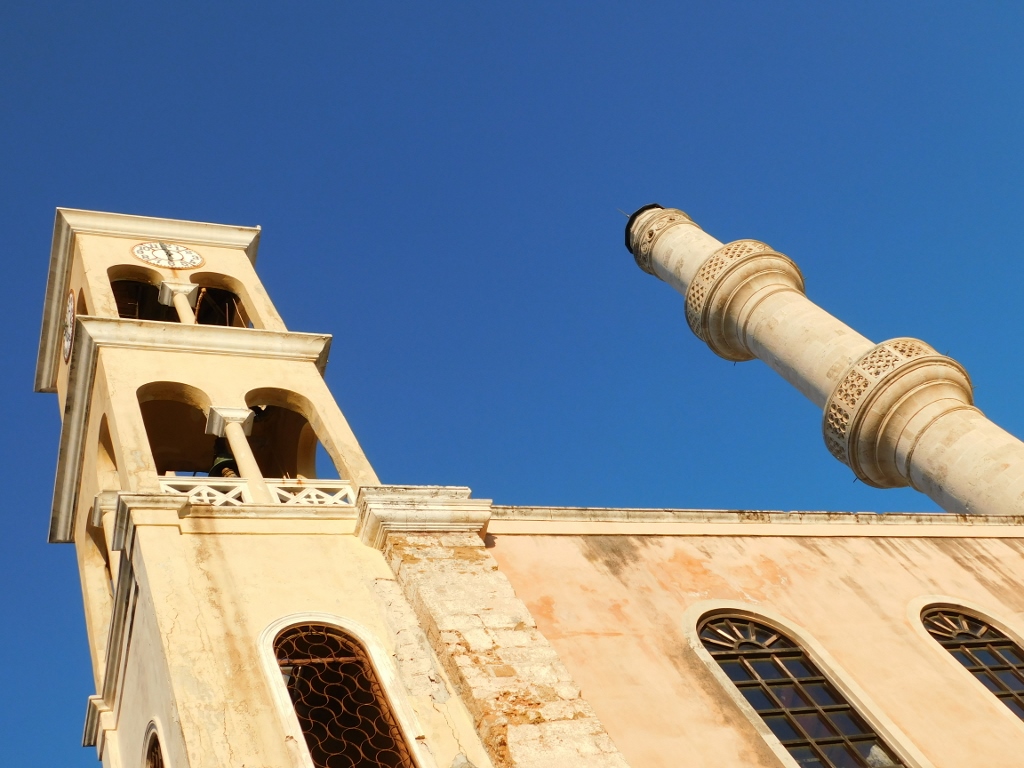 Church of St. Nicholas, a detail
Church of St. Nicholas, a detail
Since the church was, unfortunately, closed during my visit, all I could do was to walk around it.
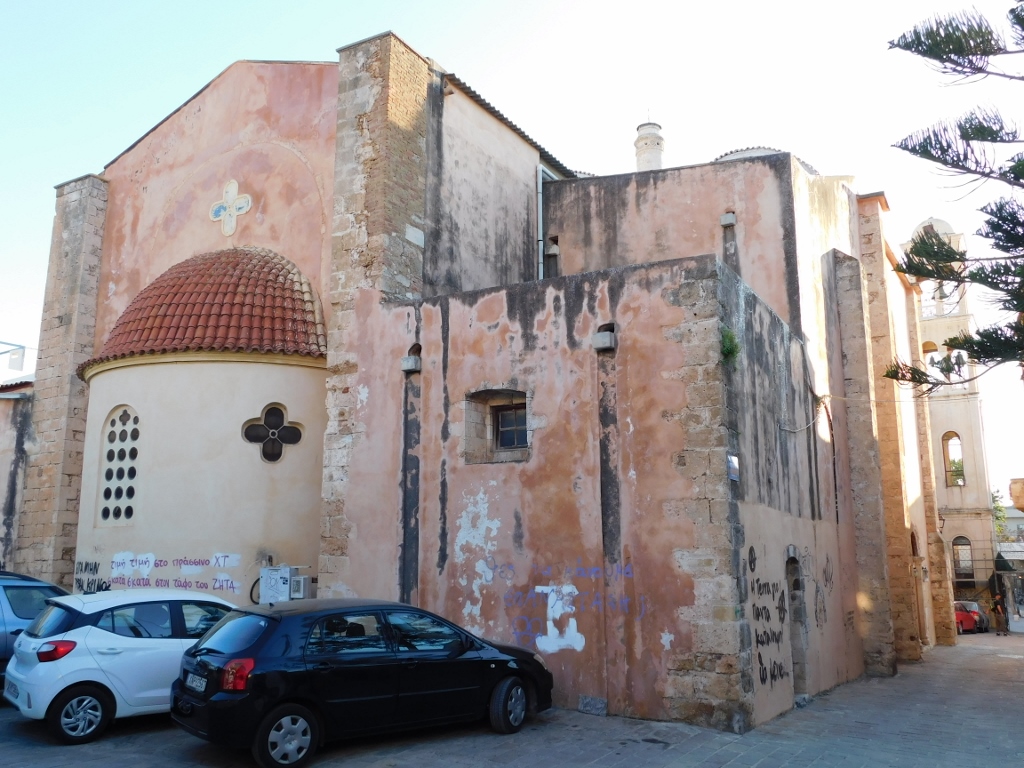 Church of St. Nicholas, a detail
Church of St. Nicholas, a detail
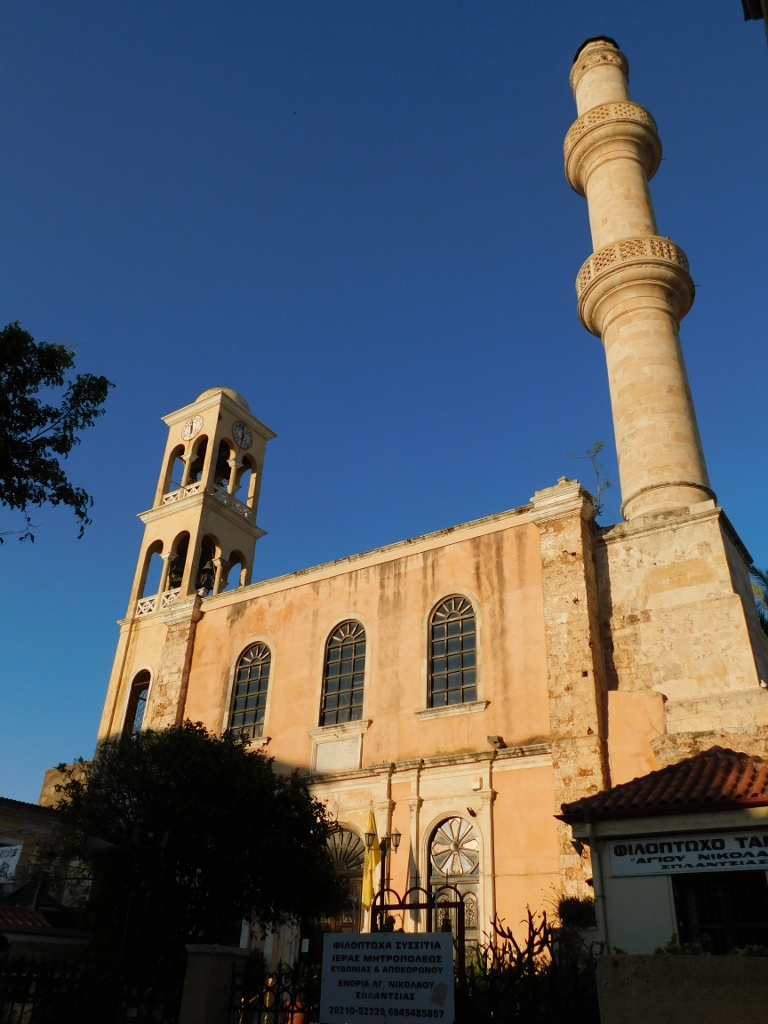 Church of St. Nicholas
Church of St. Nicholas
Going through the east parts of old Chania, I also noticed very different chimneys that seemed quite interesting.
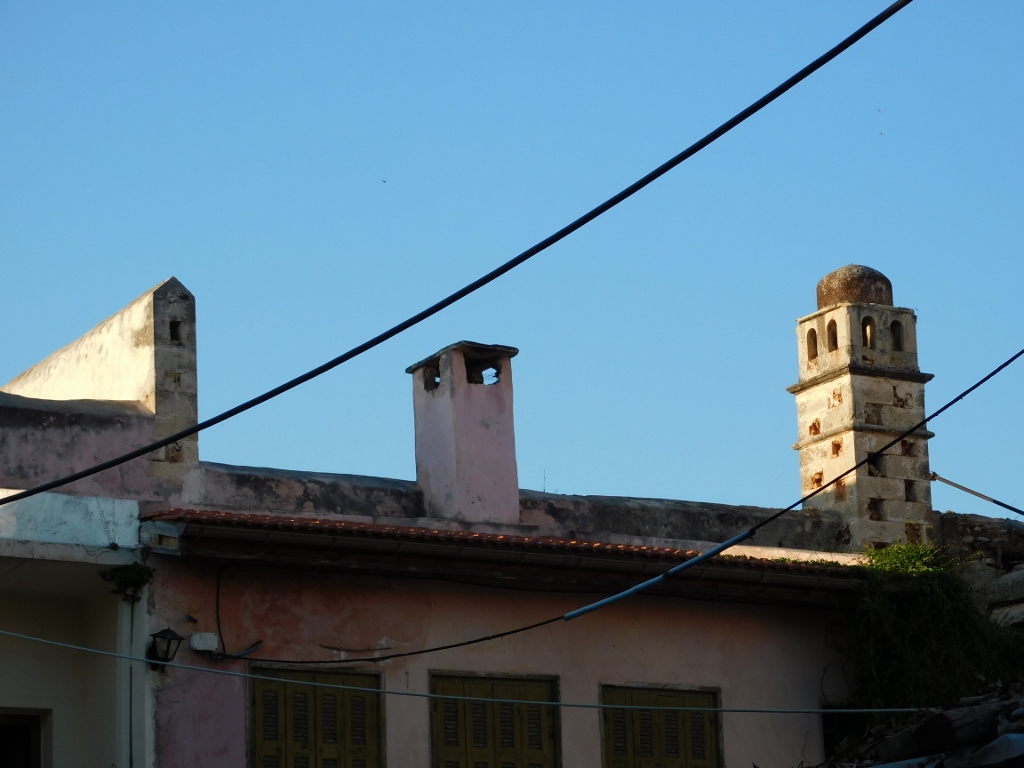 Chania, a detail
Chania, a detail
Now I headed for the sea and the marina that belongs to the old town of Chania, primarily in order to see some other buildings from the period when the Venetian Republic ruled Chania and Crete; such as the Venetian shipyards.
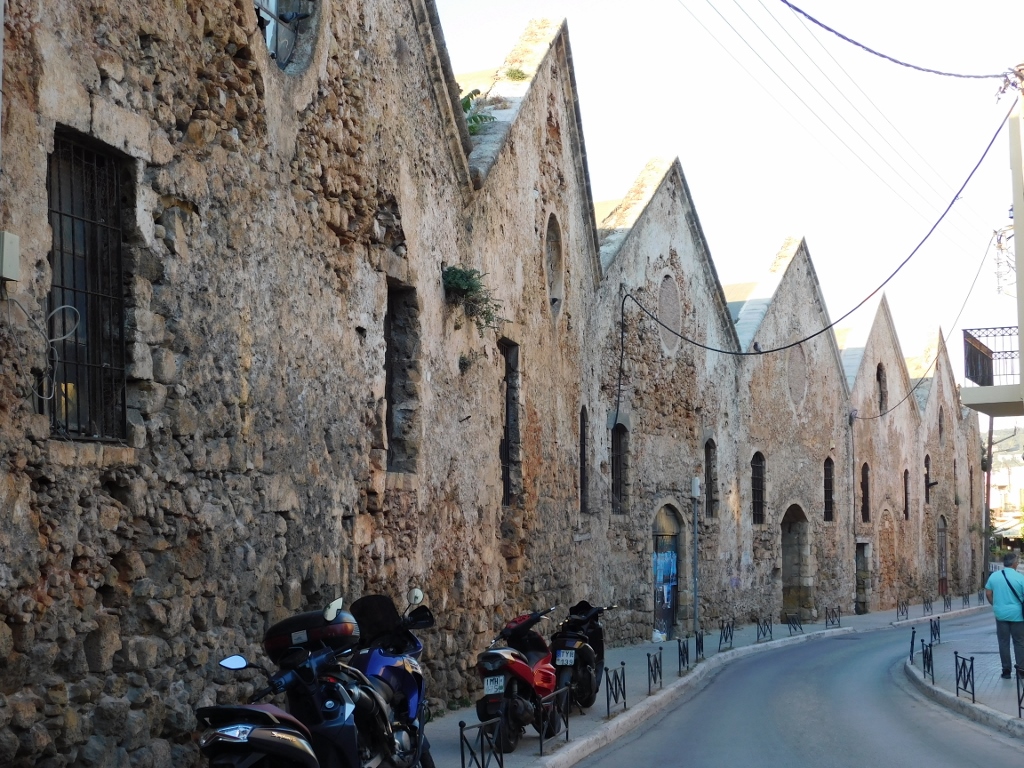 Venetian shipyards
Venetian shipyards
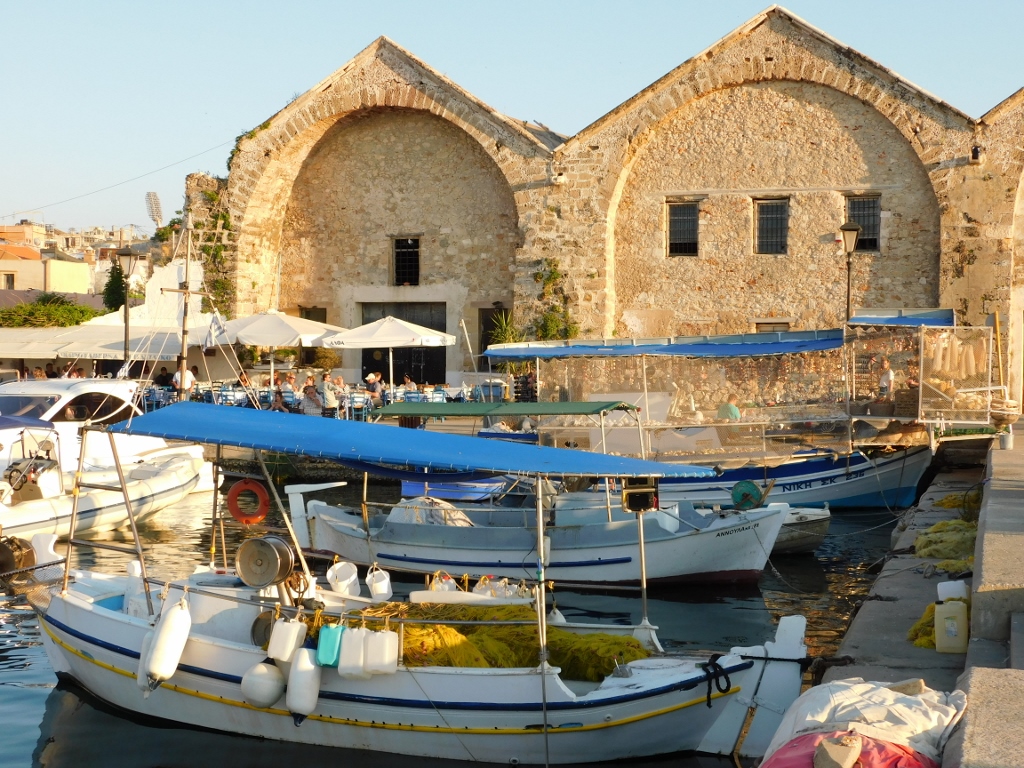 Section of the Venetian shipyards as seen from the marina
Section of the Venetian shipyards as seen from the marina
Once you get to the shore in this area, i.e., when you get to Chania Old Town Marina, you can proceed eastwards in order to get to one of the town’s beaches (although the beaches in the west seem better) and you can also go for a nice walk all the way around the marina and to the Lighthouse of Chania, which would be a nice 1-km walk. I did not do that, but rather opted to return to the Old Venetian Port of Chania taking photos along the way and with an intention to sit somewhere for a coffee.
Thus I first walked past the Katechaki Square where on the east side there is the Old Customs House which has over time been turned into the Mikis Theodorakis Theatre, named like that after the famous Greek composer.
On the south side of the square there are visible remains of the Venetian fortifications and there is also the hillock of Kastelli where, as I’ve mentioned, there are remains of the Minoan settlement and palace, as well as remains of the Monastery of Santa Maria dei Miracoli that was certainly built on top of the remains of the old settlement that had been buried with earth over time.
And on the west side of the square there is the Grand Arsenal house that was originally built in 1585, but had additions made during the period of the Ottoman rule, in 1872. The building has been recently restored and nowadays it hosts the Centre of Mediterranean Architecture where important cultural events, exhibitions and symposia are organised.
 Katechaki Square: Kastelli hillock is to the left and the Centre of Mediterranean Architecture is to the right
Katechaki Square: Kastelli hillock is to the left and the Centre of Mediterranean Architecture is to the right
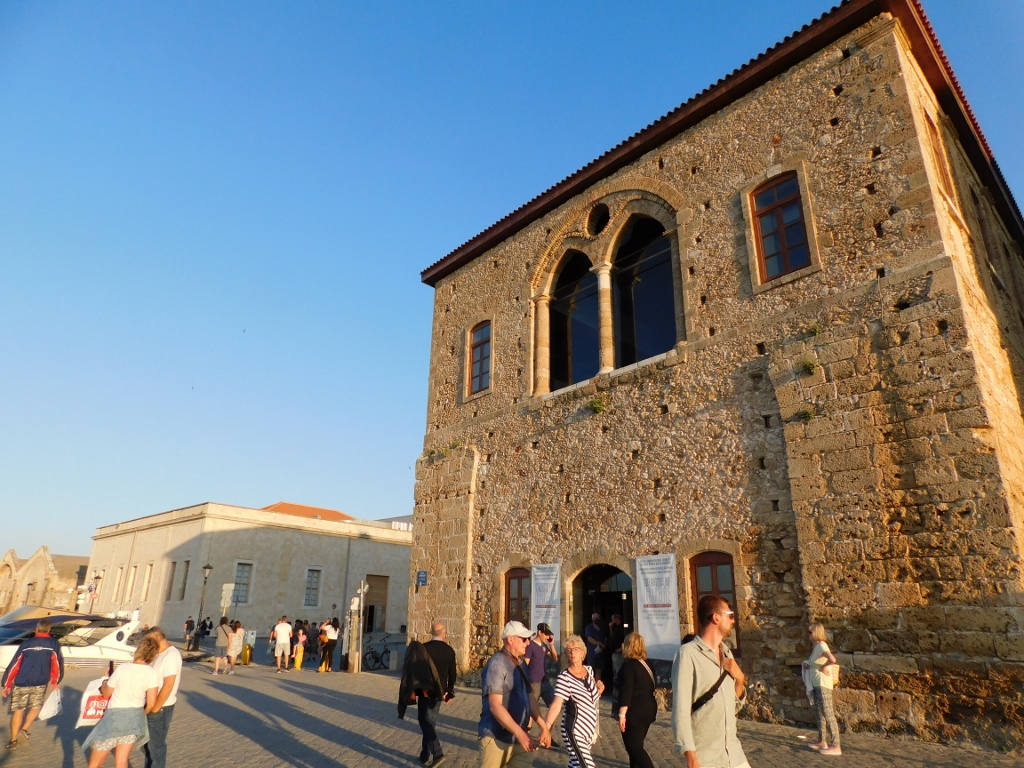 The whitish building on the left is the Mikis Theodorakis Theatre, followed by the square, while the Centre of Mediterranean Architecture is on the right
The whitish building on the left is the Mikis Theodorakis Theatre, followed by the square, while the Centre of Mediterranean Architecture is on the right
Soon I reached a pier from which I had a beautiful view all over the place and then I took advantage of the fact not only in order to enjoy the sights, but also to take photos.
 View at the Chania Old Town Marina; the breakwater is on the left and Kastelli hillock is on the right
View at the Chania Old Town Marina; the breakwater is on the left and Kastelli hillock is on the right
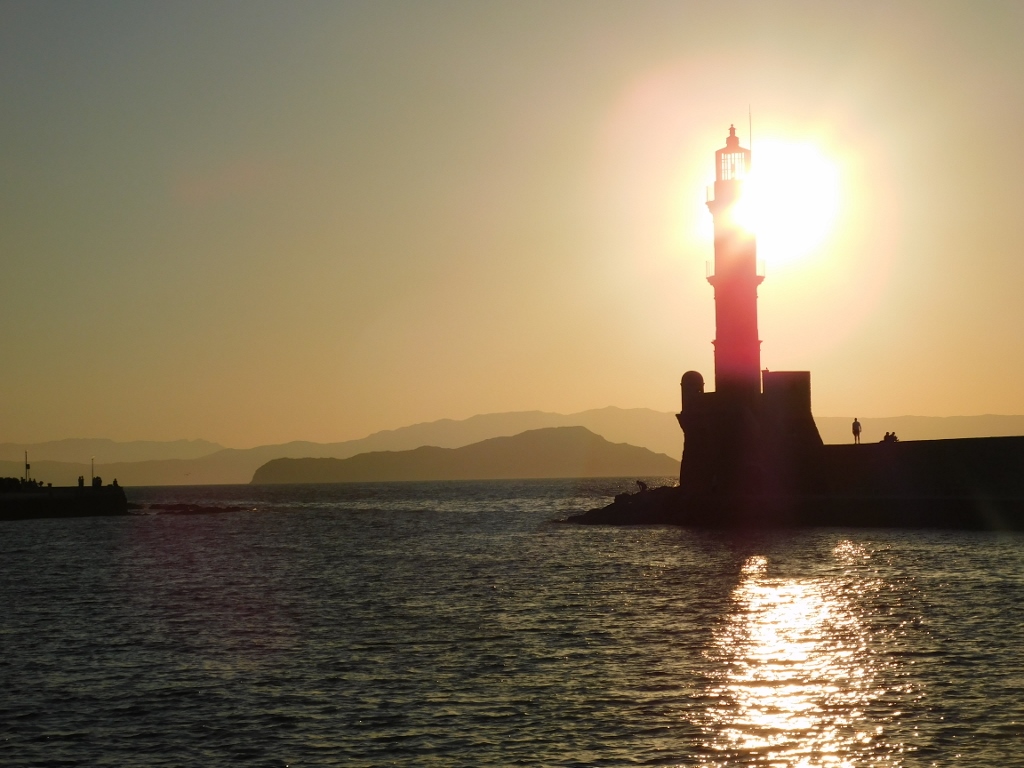 View at the Lighthouse of Chania
View at the Lighthouse of Chania
 The pier I’m standing on is in the middle, the Chania Old Town Marina is on the left and the Old Venetian Port of Chania is on the right
The pier I’m standing on is in the middle, the Chania Old Town Marina is on the left and the Old Venetian Port of Chania is on the right
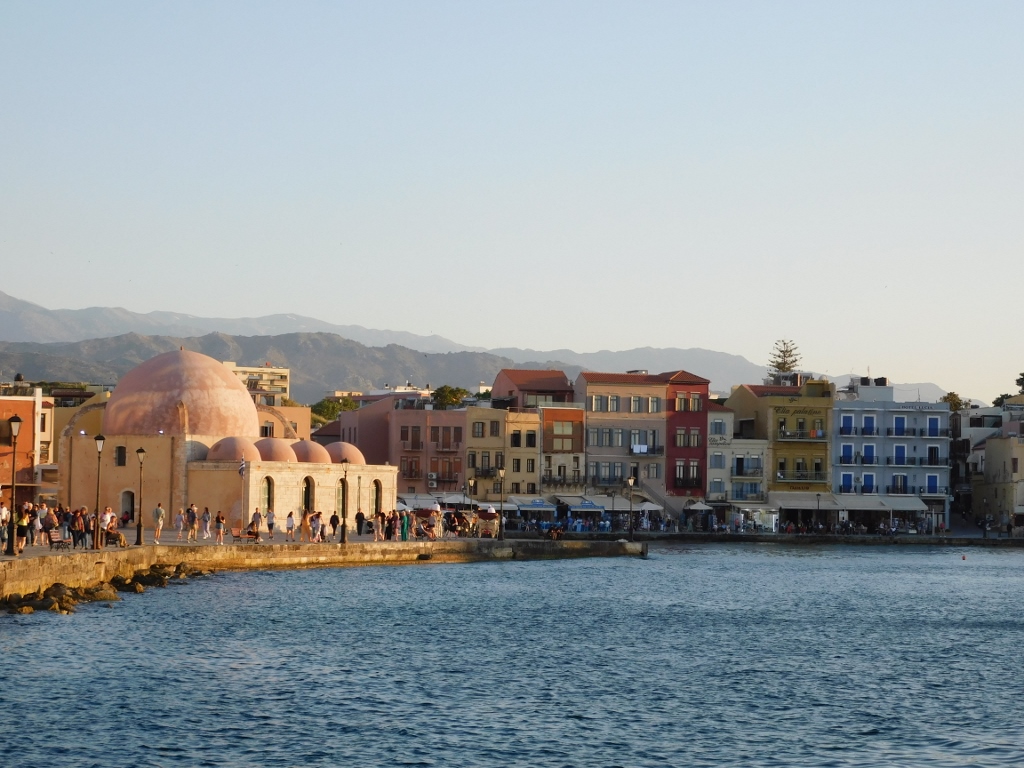 Part of the Old Venetian Port of Chania with the former Küçük Hasan Pasha Mosque on the left
Part of the Old Venetian Port of Chania with the former Küçük Hasan Pasha Mosque on the left
 Old Venetian Port of Chania, view at the west sections of the old town
Old Venetian Port of Chania, view at the west sections of the old town
Now was the time to sit down and take a coffee, which I did at one of the numerous cafés/restaurants along the promenade by the Old Venetian Port of Chania.
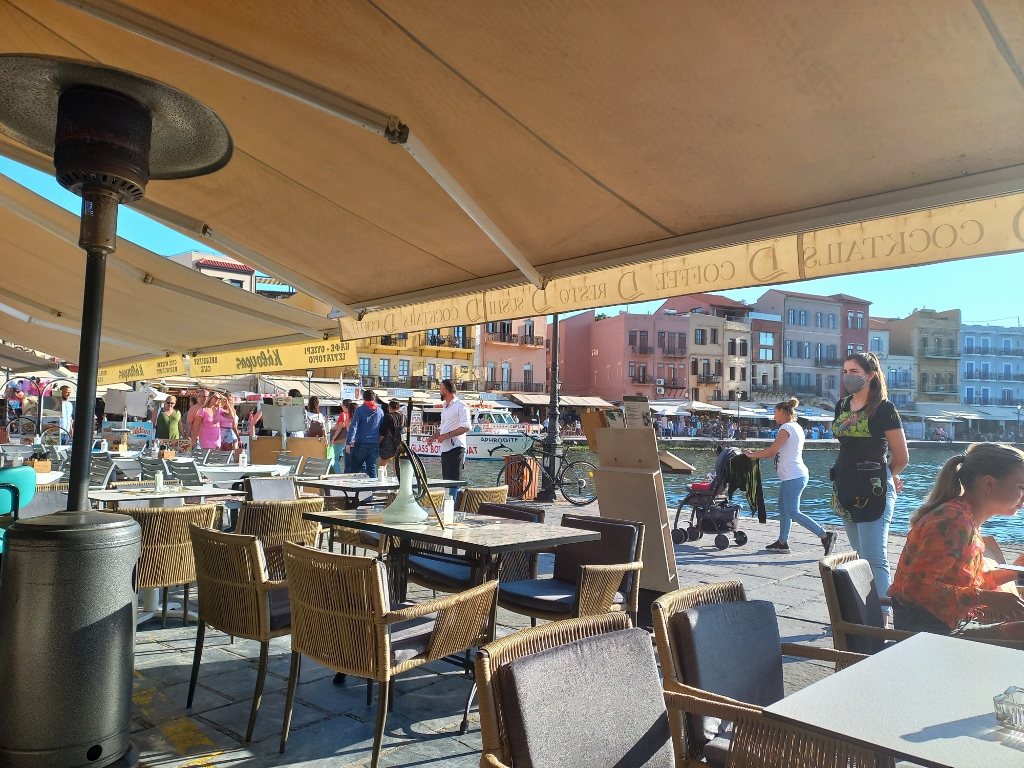 Enjoying the late afternoon sun in Chania
Enjoying the late afternoon sun in Chania
What I particularly liked in all the cafés and restaurants on Crete where I went was that they automatically brought you drinking water. You certainly pay for the water through what you have ordered, but I think this is an exceptionally nice and good custom. Especially when you do not only use water in plastic bottles. Irrespective of whether the plastic bottles are recycled or not, for, by the way, recycling is just a good business after all.
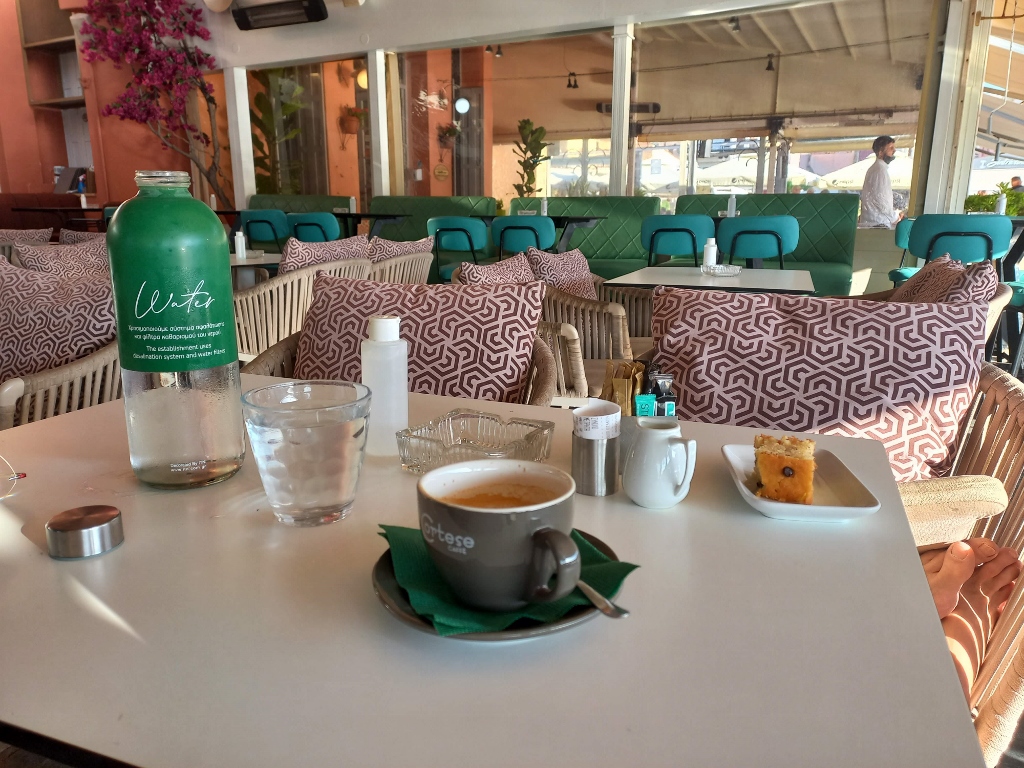 Enjoying the coffee and water
Enjoying the coffee and water
After this break I went to a tourist agency where I paid for a couple of excursions I was going to go to over the next days. As it is quite clear, I love to visit most of the things on my own and based on my own organisation, but it is often good to go for day trips for these are all well developed things, so why try to re-invent a wheel.
And since I was very efficient in this, I returned to the Old Venetian Port of Chania and just continued to yet another café on the opposite side in relation to the one where I had my coffee. Now I opted for something completely different and before the cocktail I ordered arrived, I enjoyed the magical play of the colours on the surface of the water created by the rays of the setting Sun.
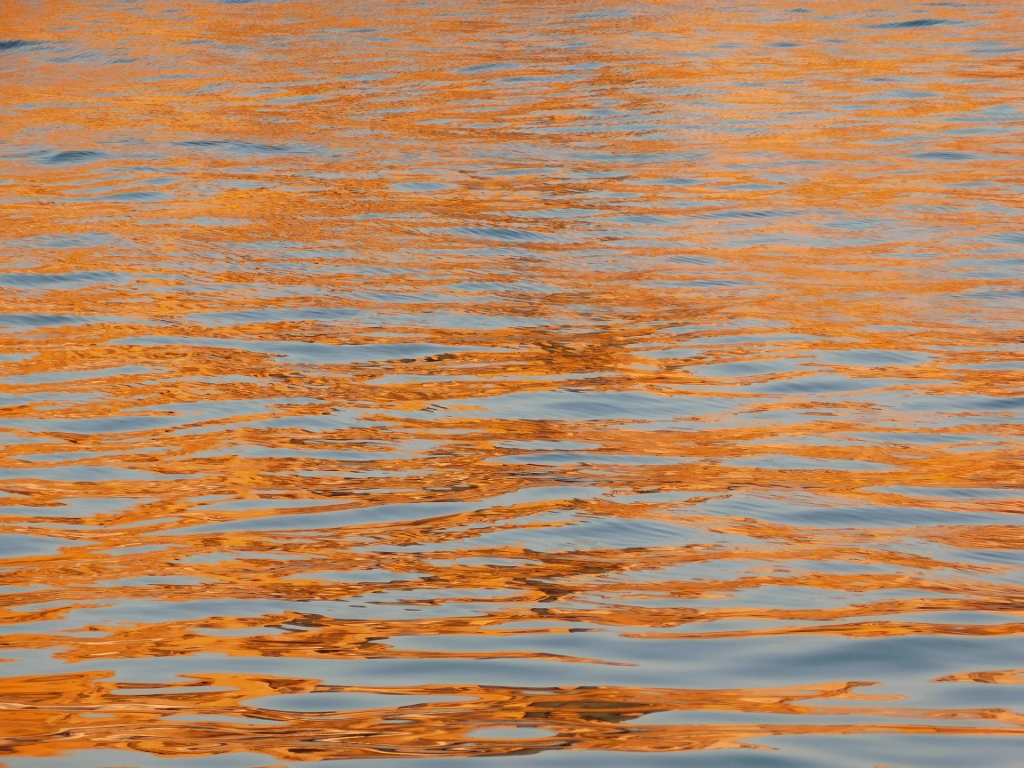 Rippling water during the sunset
Rippling water during the sunset
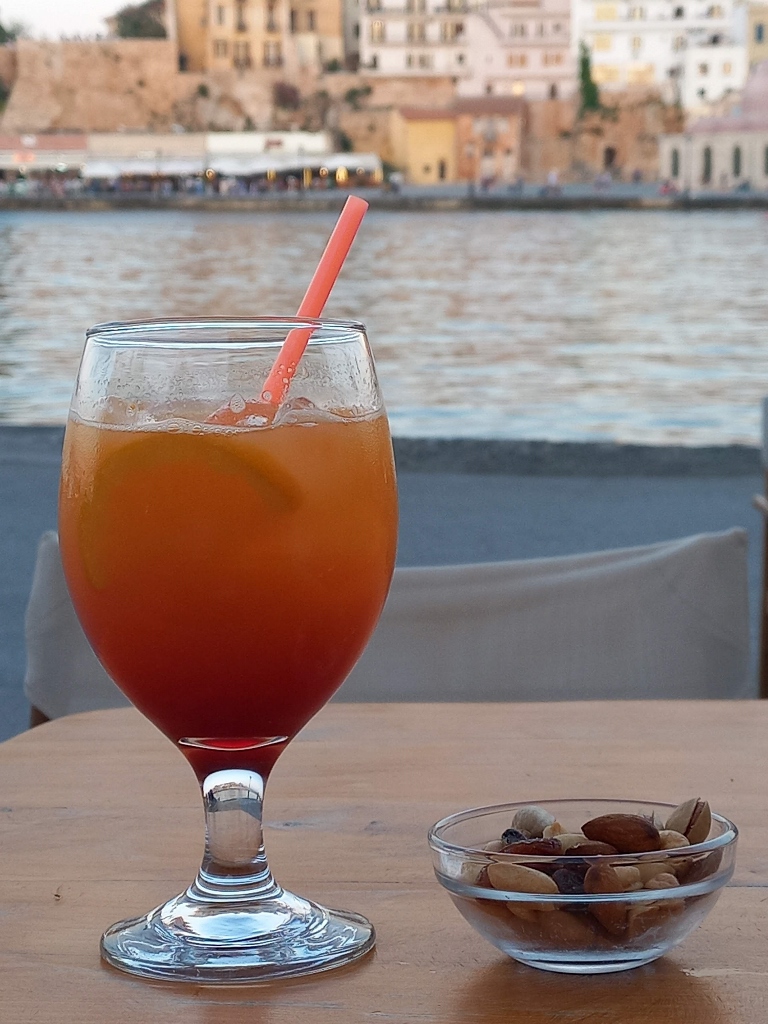 The sun is down and the cocktail and nuts are here
The sun is down and the cocktail and nuts are here
Wonderfully relaxed, I waited for the evening and then I walked a little more before returning to the rented flat, since I had to get up very early the following day.
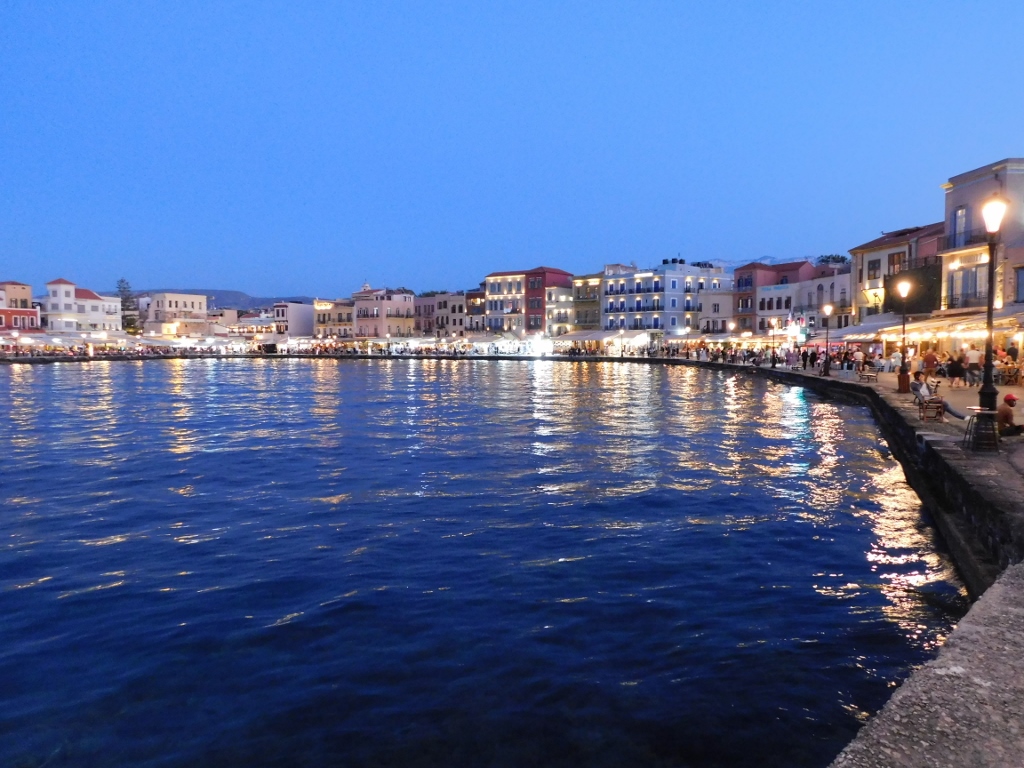 Chania at night
Chania at night
In line with the plan, I got up early the next day, got ready quickly and then headed for the place where the people who were going on this trip were supposed to gather. Since I had enough time, I enjoyed the quiet morning and the sights around the Old Venetian Port of Chania.
At the far west end of the bay where the old port is, there is the Maritime Museum of Crete. Although I have heard nothing but praises about this museum I actually ended up not visiting it. Well, ... Perhaps I can do that the next time I go to Crete. Chania itself is an exceptionally charming place, so I certainly would not mind in the least to return here.
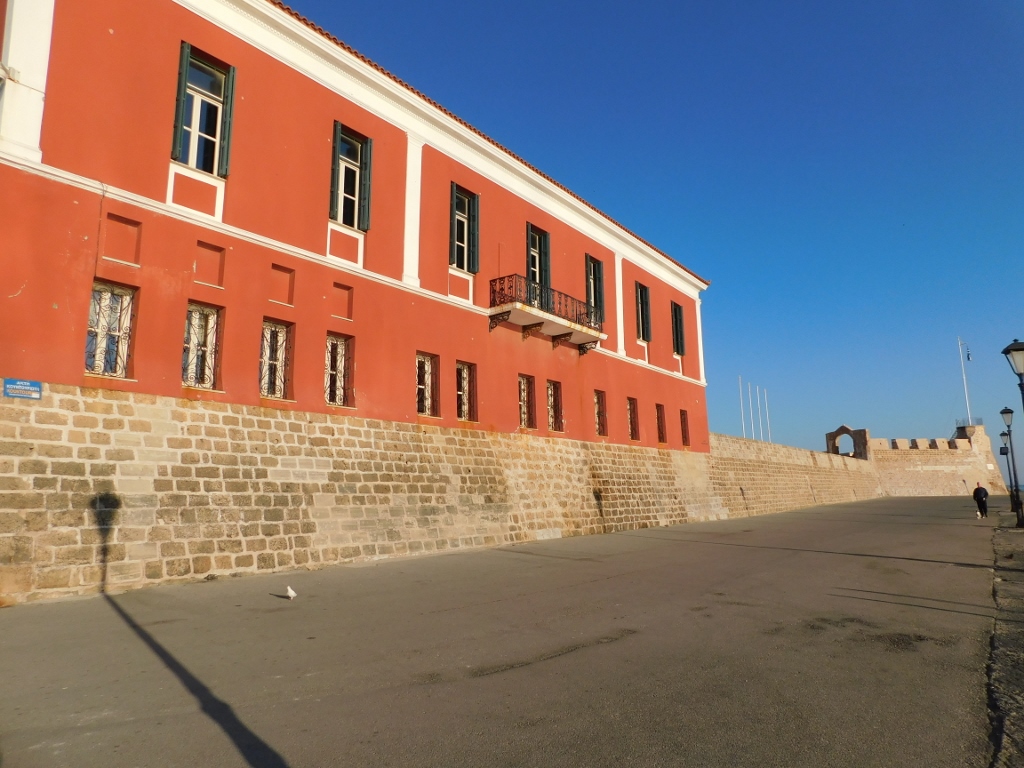 Maritime Museum of Crete
Maritime Museum of Crete
 Old Venetian Port of Chania
Old Venetian Port of Chania
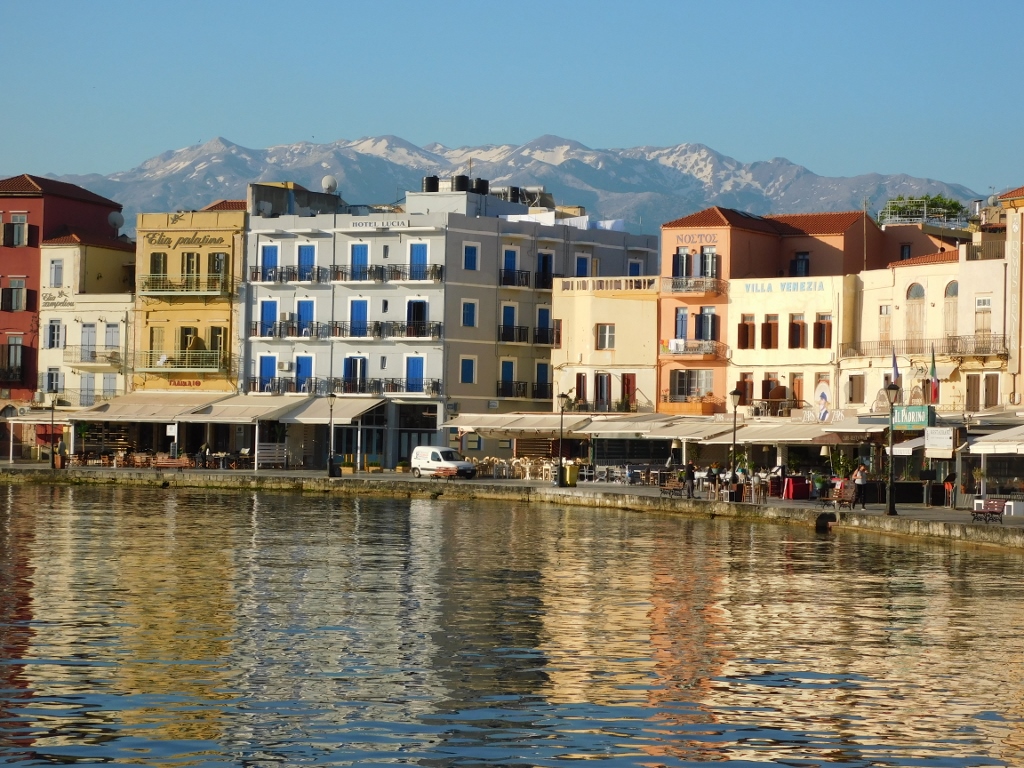 Old Venetian Port of Chania, a detail; the heights of Lefka Ori with altitude of 2453 m are in the background
Old Venetian Port of Chania, a detail; the heights of Lefka Ori with altitude of 2453 m are in the background
 Old Venetian Port of Chania
Old Venetian Port of Chania